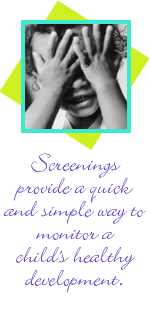|
Developmental screenings should
be a part of every well-baby visit. Screenings provide a quick and simple way
to monitor a child’s healthy development. The earlier a developmental delay or
disorder is detected, the better the prognosis for the child.
Today, according to the U.S. Department of Education, only
2.59% of children under age three are being served through the federally-funded
Early Intervention program.1 Yet, 17% of
children under the age of 18 are affected by a developmental, behavioral, or
learning disability.2
Since birth to three is a critical time in a child’s development, a delay in
diagnosis may compromise a child’s chances for success. During the first three years, children make regular visits to the physician.
At each well visit, physical development is monitored: a child is weighed and
measured, growth is charted. Well visits also provide crucial opportunities to
screen for developmental disorders, to monitor and chart a child’s social,
emotional, and cognitive development. Screening can be simple; it takes just a few minutes. It is effective, because
it utilizes major developmental milestones. Screening is important because of
the potential each child holds—potential for success, for challenges, but
above all, for change and development. To recognize a child’s risk for developmental
disorders, then, is to also recognize and maximize a child’s potential. There are a variety of ways that physicians can seamlessly weave a developmental
screening into a well visit. A parent might fill out a screening form in the
physician’s waiting room, at home before a well visit, or with the assistance
of a nurse, physician, or other professional in the examination room. With proper intervention, a child can overcome a wide range of developmental
problems. Intensive, well-designed, and timely intervention can improve the prospects—and
the quality of life—for many children who are considered at risk for cognitive,
social, or emotional impairment. Even children with conditions such as autism,
once thought to be virtually untreatable, can make measurable progress with effective
intervention. Well-implemented programs can brighten a child’s future and make
a positive impact on the entire family. Early and appropriate intervention can
be the key to greater independence, increased participation in the wider community,
and ultimately, a more productive and fulfilling life as an adult. But without
identification through screening, a child may not receive the early and intensive
interventions he or she needs. Identification is essential for intervention. Parents and pediatricians work in partnership to assure that each child grows
and develops to his or her full potential. All children will have a greater chance
for success if the first signs of a developmental
disorder are
closely monitored.
I’m going to make sure that at
every age at which I see a child I’m going to look at what enables that child
to have success. Our threshold is what brings
success to a child. Interacting brings success. Language brings success. And
being able to pay attention to somebody as they’re speaking brings success, because
that enables them to go on to other stages of development. (Robert H. Wharton,
M.D., Developmental and Behavioral Pediatrician)
To make good use of parents’ observations, which are
rich and deep, makes a lot of sense. Parents can contribute information in
the waiting room while there’s
down time for them and the pediatrician is busy with other patients. Then you
can bring the two together with a much richer source of information than you
could with just the pediatrician doing some observations. (Frances Page
Glascoe, Ph.D., Professor of Pediatrics)
For more information about screening,
click here.
For more information about the use and
selection of quality screening tools,
click here.
For recommended screening tools,
click here.
1.
Boyle CA, Decoufle P, and Yeargin-Allsopp M., (1994). Prevalence and
health impact of developmental disabilities in US children. Pediatrics.
9, 399-403. Developmental Disabilities Branch, Centers for Disease
Control and Prevention, Atlanta, GA
2.
TWENTY-FOURTH ANNUAL REPORT to Congress on the Implementation of the
Individuals with Disabilities Education Act
Back to top
Next page =>
| 



